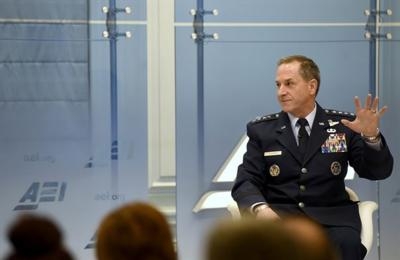Outlines His Perspective For The Future Of American Air Power
Air Force Chief of Staff Gen. David L. Goldfein outlined his perspective on the future of American airpower and how Airmen “deployed in place” play a vital role in today’s Air Force during his discussion at the American Enterprise Institute Public Forum in Washington, D.C., Jan. 18, 2017.

Since the beginning of the Cold War, Airmen have been in a state of deployment. Today, nearly 200,000 Airmen are “deployed in place,” providing nuclear deterrence, command and control and access to space, all supporting combat missions globally. During his remarks, Goldfein reflected on the fact that since the introduction of the nuclear enterprise, no two nuclear powers have gone to war, and while conventional conflicts continue to take place, the nuclear deterrent has ensured stability.
“We have Airmen right now, as we speak, defending the homeland, and that nuclear deterrent underwrites every military operation on the globe” Goldfein said.
The nation’s nuclear triad is composed of three legs: nuclear missiles, nuclear capable aircraft and nuclear submarines, each essential for different reasons, and each needs to be modernized, Goldfein said as he held up an 8-inch floppy disk as one example of outdated technology the nuclear triad operates with.
Goldfein went on to talk about the Air Force’s commitments to operating in space.
“We’ve been a steward of space since 1954 when a guy named Bernie Schriever started developing the rocket enterprise that has expanded now to the point where we as an Air Force are responsible for 12 constellations,” Goldfein said.
Goldfein further explained how vital “deployed in place” Airmen at Schriever AFB, Colorado, are to the joint force because of the global effect space provides, and he went on to remind the audience that the Air Force’s work in space impact not just the military, but everyone.
The general then highlighted the 35,000 Airmen “deployed in place” who work in the cyber domain taking care of all the ones and zeroes the Air Force collects and turning it into quality information for the joint warfighter.
Bringing it closer to home, Goldfein pointed out that “right now, as we sit, we have got Airmen on alert at the four corners of the globe, and that there are Airmen right now at Joint Base Andrews, (Maryland), who are on alert ready to defend the homeland--to scramble if required … all of these Airmen are contributing to the homeland defense.
“It’s important to understand that these are Airmen that I would not deploy forward if a contingency accrued,” Goldfein continued. “Because they are doing their mission at home … when you want to talk about striking forces in the fight against (the Islamic State of Iraq and the Levant), securing the homeland or providing all of this capability, the reality is you can’t find a mission the joint force performs where an Airman is not engaged and is essential for success.”
Throughout the Air Force’s 70-year history, the service has adapted resources to mission requirements; however, that trend stopped about 25 years ago, the general said.
According to the general, most of America still remembers the Air Force during Operation Desert Storm. It was a time when there were 134 fighter squadrons across the total force from which the Air Force deployed 34 squadrons to execute Operations Desert Shield and Desert Storm. Now there are only 55 fighter squadrons total.
“Missions have grown and I predict they will continue to grow; space, cyber, ISR and nuclear – these are not going to go down,” Goldfein said. “So we’ve had 50,000 Airmen leave the Air Force while missions have grown. So we have a math problem … where we sit today as an Air Force is we are too big for the resources available, but far too small for what the nation demands of it and what the joint force requires.”
The general made clear that it’s time to once again adapt resources to bring them in line with not only today’s requirements, but those of the 21st century.
(Image provided with USAF news release)
 Senator Pushes FAA to Accelerate Rocket Launch Licensing
Senator Pushes FAA to Accelerate Rocket Launch Licensing Classic Aero-TV: RJ Gritter - Part of Aviations Bright New Future
Classic Aero-TV: RJ Gritter - Part of Aviations Bright New Future Aero-FAQ: Dave Juwel's Aviation Marketing Stories -- ITBOA BNITBOB
Aero-FAQ: Dave Juwel's Aviation Marketing Stories -- ITBOA BNITBOB ANN's Daily Aero-Linx (10.27.24)
ANN's Daily Aero-Linx (10.27.24) ANN's Daily Aero-Term (10.27.24): Clearance Void If Not Off By (Time)
ANN's Daily Aero-Term (10.27.24): Clearance Void If Not Off By (Time)



